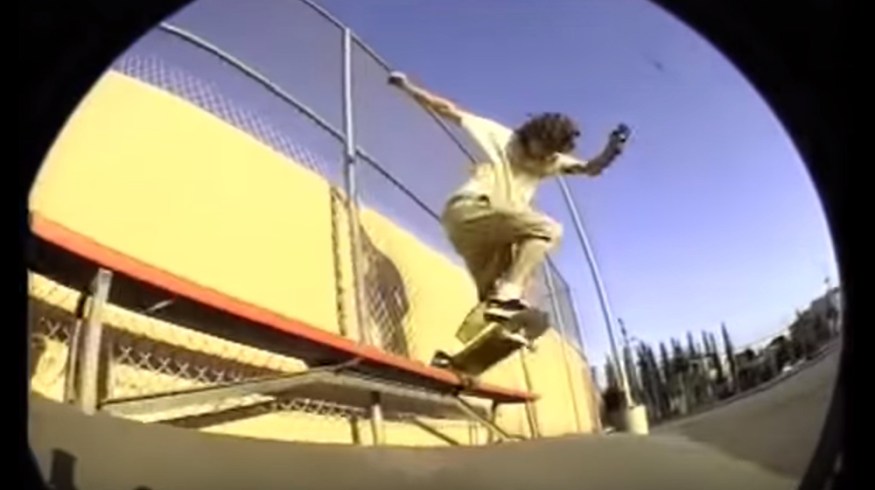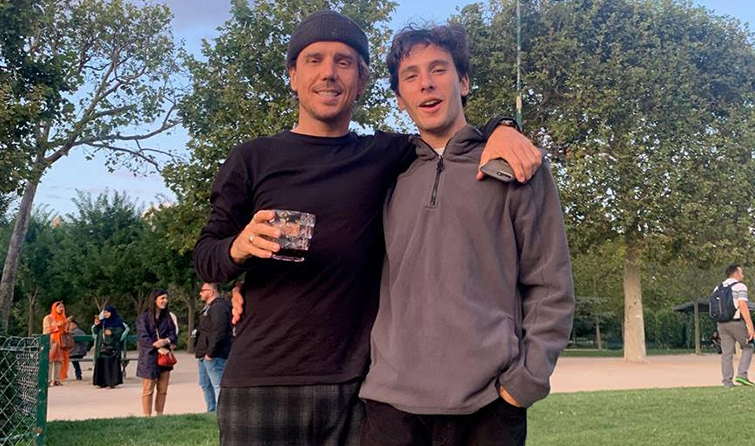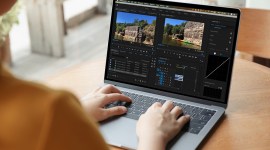
The History of Skate Videography: The Unsung Hero of Cinéma Vérité
Let’s dive into the history of the skate video and how skateboarding has influenced the videography and filmmaking landscape.
I remember the first skate video I ever watched. I was ten — a short, slightly chubby little kid who wore chunky Etnies skate shoes, a puka shell necklace, an ill-fitting Independent Trucks T-shirt, and I had just received my first skateboard that Christmas. A friend and I had just got a ride from his mom to the local skate shop, Soundwaves, and he bought the DVD for Geoff Rowley‘s “Sorry” video from his sponsor company, Flip. We brought it home and popped it in the DVD player for his giant CRT TV. I remember just being completely enamored with the visuals, the insane tricks Geoff was pulling off, the kickass music, and the dingy aesthetic from a VHS camcorder recording on a fisheye lens. Even though I couldn’t even pull off an ollie at the time, that video sparked my dreams of one day being sponsored, so I could be like my heroes — Tony Hawk, Rodney Mullen, Bob Burnquist — just to name a few. It’s a story most kids who grew up in the ’90s through early 2000s are quite familiar with.
You know, I never got sponsored, and by the end of my short skateboarding career, I could barely even “manual” for more than two seconds. It happens when you are an awkwardly shaped preteen that decides he might be better at sports that don’t require so much balance and agility. But, what did stick around was my love for the skate video.
Videography and skateboarding have gone hand-in-hand since the advent of strapping four wheels to a board. Skate videos are what influenced a lot of the culture of the mid-90s to the early 2000s — the fashion, the anti-establishment feeling they conveyed, and especially the style of filming they used. Skate culture was in the zeitgeist, with a lot of the popular bands at the time (Blink-182 and Sum 41) drawing a lot of their inspiration from the aesthetic, and popular filmmakers emulating the style in their creative projects.
So today, we’re going to dive into the history of the skate video, what constitutes the style of a skate video, and how pervasive it is in filmmaking and videography, to this day.
The History of the Skate Video
As skating started with humble beginnings, so did the skate film. Back in the days when skateboarding was just gaining popularity, most of the competitions you entered were “Vert” competitions, hosted in abandoned swimming pools and purpose-built bowls. Stacy Peralta shot these videos — one of the original members of the Zephyr Skate Crew featured in the movie Lords of Dogtown and featured as VHS tapes titled The Bones Brigade Video Show, which featured the top skaters of the time, including a young Tony Hawk. Since handheld camcorders hadn’t become widely available at the time, most of these early videos used professional equipment sponsored by Powell — Peralta Productions or the skate brand Santa Cruz.
The true origin of the skate film, as we know it today, came along with the advent of the commercially available personal camcorder. Many of the skaters who grew up watching the Bones Brigade tapes were desperate to star in their own skate movies, and once their parents bought a camera to capture home movies, it became easier to ask dad to borrow the family camcorder to shoot a short video with your buddies. This new wave of skate videos brought us one of the most influential skate videos of the time — “Shackle Me Not” by the skate collective H-Street.
H-street originated from two buddies, Tony Mag and Mike Ternasky, who founded the first skate company run by skateboarders. They set out to make a skate video reminiscent of the old Powell videos, but with resources they could afford. “Shackle Me Not” (1988) was their first project, which included all of the basic tenets of what we think of when we hear “skate video” today — the fisheye lens, the grungy DIY aesthetic, the fun inserts between tricks that let you get to know the skaters in the video. In “Shackle Me Not,” you get a peek into the lives of Danny Way, Matt Hensley, Eric Koston, and many more skaters of the time.
Skate videos were now diaries of the skaters presented within them — it was an opportunity to showcase your skills and personality to both skate fans and (more importantly) sponsors.
The Rise of Sponsored Content
After H-Street invaded the VHS players of the day’s youth, skate companies began to realize the power of the skate video. It was a way to bring sponsored content directly to skaters’ hands, aligning their brand with certain skaters they liked. It was a mutually beneficial relationship — the skate companies created brand recognition using skaters who promoted their products, and skaters got money.
About three years after “Shackle Me Not,” skate brand Blind enlisted the help of extreme sports photographer Spike Jonze, who you might recognize as the acclaimed director of Her, Being John Malkovich, and Where the Wild Things Are, to create a new skate video called Video Days (1991). This video featured Mark Gonzales, Jason Lee, and other skate legends. It’s considered one of the defining videos of the genre, influencing countless other videos to follow with its easygoing template and shot format. From the intro of all five skaters in an Oldsmobile driving around to “Low Rider,” to the absolute killer street-skating performance they all put on, it’s gone down in skate history as one of the best videos ever to grace the genre.
After Video Days came an onslaught of some more legendary skate videos throughout the ’90s and into the 2000s, such as Girl’s “Mouse” (1996) and “Yeah Right!” (2003), and Toy Factory’s “Welcome to Hell” (1996). All of them followed the same archetype, and they started solidifying how a skate video should look.
“Yeah Right!” Full Video | Girl Skateboards (2003) from Crailtap on Vimeo.
The Defining Look of a Skate Video
After most of the ’90s hits came out from companies such as Plan B, Toy Factory, and Girl, the “look” was pretty much solidified. Some would say its definition came from the “holy grail” of skate filmmaking — the Sony VX1000. Others say it’s a combination of aesthetics and style. In my opinion, it comes down to three things that define the skate video from this era:
- Fisheye/Wide Lenses: Most skate videographers shoot with either a wide frame lens or fisheye to capture all of the action happening in the shot. Because skaters move fast through a frame, it’s better to stay safe and keep it wide just in case a skater lands a trick, and you want to be sure to capture it. One of the big, stylistic choices with this style is keeping the ring of the fisheye lens in the shot — giving the video grit.
- Crunchy Colors: Due to the colors that the video cameras at the time captured, the skate video has a trademark “crunch” to its colors. The vibrant crispiness of the video really makes it feel lived in.
- 4:3 Layout: As with the other aesthetic properties above, the 4:3 layout of most skate videos came from the cameras they were captured on, not from a stylistic choice. And out of necessity came preference. The 4:3 layout is a trademark of the classic skate video.
Skate Video Aesthetics in Film and Television
After skate videos made their mark on the zeitgeist, the aesthetic started bleeding into the film and television industry. Directors like Spike Jonze, who made their debut in the skate videography world, began getting jobs within the industry.
The first thing that comes to mind for me is the Jackass series. Run by a crew of skaters, the Jackass crew emulated what a lot of skate videos brought to the world — fun, exorbitant pranks and gaffs that showcased the personality of the skaters. Jackass took that bit and ran with it, shooting absolutely wild skits out in the open, to the dismay of a lot of the public.
The format slid its way into music as well, with bands like Blink-182 being in tune with the skate culture of the time. Their music video for “The Rock Show” had some slices of skate video aesthetics, with them cashing a check from a production company and throwing the bills all over town, giving someone a makeover, and trashing a brand new TV.
Then, fast forward to recent years, and we’ve got people who grew up with skate videos as kids in the ’90s and 2000s, such as the rap collective Odd Future. This crew draws heavy influence from skate culture, with artists in the group like Tyler, the Creator and Earl Sweatshirt creating music videos with all of the tell-tale signs of a bona fide skate video.
Another kid who grew up in this era — Jonah Hill — made his directorial debut with the A24 hit of the year — Mid90s. All of the influences are there in this love letter to the ’90s skate era, especially with the stylistic choice to present the movie in a 4:3 ratio. The kids in the movie are constantly shooting their own skate videos, hoping to one day get sponsored — just like many of us who grew up on a board.
The Current State of the Skate Video
With high-quality video production gear becoming more accessible to consumers, and phones carrying powerful cameras, it’s never been easier for people to get out there and record a skate video. Social media has also played a huge role — kids no longer have to do reel-to-reel editing on a VCR to get a single VHS tape that they have to copy and produce themselves. Now, all you have to do is record something on your phone, give it a quick edit, and it’s ready to post to the masses.
Access to editing programs and consumer cinema cameras have changed what a skate video entails. We’re seeing more sweeping cinematic shots, integration with motion graphics, and cleaner videos. Skate brands are also aligning themselves with filmmaking brands and social media influencers, such as Vans teaming up with Adobe and the lifestyle brand Life Without Andy to document their latest competition — the Vans Park Series. Life Without Andy was there to document the series, and then edited all of the footage on Adobe’s newest editing program — Adobe Rush.
We actually got to sit down with Life Without Andy to talk with them a bit about their relationship to the skate video, and how they see the future of skate videography with the advent of social media and accessible gear.
PremiumBeat: Tell us a little bit about your background and your relationship to skate videos.
Life Without Andy: When I was about ten years old, I started skateboarding, and a few years after that I picked up my first camera. To me, skate videos were my childhood. I would stay up all night after a long day at the skate park, just watching skate videos and getting excited for the next day of skating. It inspired me to create my own videos and taught me there is no one way to create or do something.
PB: What was the most influential skate video you remember watching when you were younger?
LWA: My all-time favorite skate video was Flip’s “Extremely Sorry.” I would watch that almost every day.
PB: How do you think skate videos have influenced pop culture over the years?
LWA: I think skate videos have influenced so many aspects of fashion and art, and I couldn’t imagine what I would be doing if I hadn’t got inspiration from them to be who I am today.
PB: What are you most excited about working with the Adobe team and the Vans Park Series?
LWA: I am just excited about the journey of creating with such a dream team. I mean, if you were to tell fourteen-year-old Noah I would be working with Vans and Adobe creating videos, I wouldn’t believe you. Getting to travel the world and learning from Adobe is just unreal.
PB: What’s your experience working with Adobe Rush?
LWA: I just started using it a couple of months ago, and it’s now a go-to program for me when I want to whip something up and have it straight on the socials. I love being able to change the aspect ratio of my projects for Instagram stories and the ease of the color correction tool!
PB: What did/do you record your videos on when making a skate video?
LWA: My first camera was a Sony VX1000, which was and still is the holy grail of skateboard filmmaking. That got me started. From there, I have been forever changing my filming gear, from Cannon DSLRs to Sony Dad cams, and even working with RED cameras on some jobs, these days.
PB: How do you think skate videos have changed with the advent of social media, camera phones, and more accessibility to videography equipment?
LWA: I think skate videos have changed in the sense that because there is so much content coming out, everyone is constantly trying to make something new and unique, which is super exciting to see.
Cover image via Girl Skateboarding and Spike Jonze (Mouse, 1996).
Looking for more on the filmmaking industry? Check out these articles.







